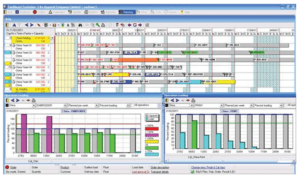LEAN Manufacturing in RMG: Barriers to achieving ‘LEAN’ and the essential role of planning
by Wesley Ekman
Table of contents
- Background
- So what exactly is LEAN?
- Steps to becoming LEANER
- Examining the causes of waste
- JIT (Just in Time), PULL System & Kanban
- Fundamental barriers to LEAN
- The vital role of planning in the LEAN environment
- LEAN needs standard procedures and processes.
- Additional LEAN concepts – KPI Alignment
- Planning & LEAN – The FastReactPlan approach
- Summary & Customer testimonials
1. Background
As competition and pressure on profit margins grow, fashion manufacturers are increasingly looking wider for inspiration on how to maintain a competitive business. With its roots in automotive manufacturing and largely developed from the Toyota Production System (TPS), “LEAN Manufacturing” is one of the current strategies being adopted in our industry.
A number of companies, such as sportswear giants Nike and Adidas have been promoting LEAN in their supply chains since the late 1990s.
In this article, we consider ‘LEAN’ concepts, some of the fundamental barriers to achieving LEAN and the vital role of planning in achieving the required levels of visibility and coordination to support LEAN.
2. So what exactly is LEAN?
Through time and continuous improvement, LEAN has become a collection of evolved process management principles and tools.
LEAN as a broad concept aims to ensure that all resources used (the 5 ‘M’s’) i.e.
- Man
- Material
- Methods
- Machines
- Measurements
all add “value” to the finished product and, as such, all actions or processes performed are something that a customer would be willing to pay for.
Simply put, LEAN is about creating more value with less work by eliminating waste from the business process.
3. Steps to becoming LEANER
For many LEAN followers, the first steps are to identify and eliminate waste (MUDA in Japanese) from the manufacturing process.
WASTE becomes a very broad concept and can fall into 8 categories:
3.1 Defects – Making products that are not suitable for sale or require reprocessing to bring them up to standard. This is the conventional ‘narrow’ definition of waste.
3.2 Transport – An activity that moves materials or products more than is required.
3.3 Waiting – Non-productive time, people waiting for processes to finish or material to arrive at their workplace.
3.4 Inventory – Raw materials or Work In Progress (WIP), standing, waiting for further actions to be carried out.
3.5 Extra Processes – Activities carried out on materials/products that do not add value.
3.6 Movement – Unnecessary movement of people to get materials or tools.
3.7 Over-production – Producing items that have not been ordered or that are made earlier than the required delivery date.
3.8 Knowledge disconnection – When suppliers and customers are not linked with information to support their interaction – waste occurs as businesses are unable to adjust to each other’s requirements.
It can be seen from the different categories of waste that companies must look at a much bigger picture and not just the factory floor to become leaner.
Once waste has been identified, it can then be measured and this helps in prioritizing the areas to tackle first. Then, through a combination of common sense, industrial engineering and ‘lean tools’ the process can be modified to reduce waste.
4. Examining the causes of waste
Many experts believe that businesses carrying out LEAN projects are often too quick to look directly at MUDA or waste.
The Toyota system (TPS), instead of focusing immediately on waste, starts by looking at improving the flow or smoothness of work and thus eliminating imbalance or unevenness (MURA in Japanese).
The third key concept of TPS is MURI, which is all the unreasonable work that is required due to poor organisation, product/process design, or systems. Unreasonable work is almost always a cause of waste because people are working under pressure or without defined guidelines/methods. TPS logic states that reducing the time and amount of activity required to finish a process from start to finish is one of the most effective ways to eliminate waste and lower costs.
So;
- MURA – Imbalance or unevenness in the manufacturing cycle caused by a lack of smooth flow of work.
- MURI – All unreasonable work that is required because of poor organization, product/process design or systems.
- MURA and MURI both lead to MUDA (waste).
5. JIT (Just In Time), PULL system & Kanban
Various established techniques are used to reduce inventory and throughput time. Most people have come across at least some of these including:
- Value Stream Mapping
- Balancing (Yamazumi)
- “Pull” Production/JIT (Just In Time)
- Heijunka Scheduling
- Kanban (WIP control)
These concepts all work on the principle that by reducing the safety net of excess inventory and WIP, waste such as quality problems, overproduction, and waiting becomes clear very quickly because they disrupt workflow and must be dealt with rapidly. Therefore, waste reduction happens naturally i.e. if the production flows perfectly, there is no inventory.
Many apparel factories suffer significant imbalances between consecutive production processes. Becoming ‘LEANER’ requires a more effective balance between each process and the next. Ideally, each process should only make what is required by the next process.
Because different processes, each operating in a productive manner do not have exactly the same output, then some balancing of manpower/resources between processes is required, and a small but controlled buffer (Kanban) may be allowed between each process to help smooth the flow.
In a ‘LEAN’ garment manufacturing process, the focus would be to sew JIT to meet the agreed delivery date and to ‘pull’ earlier processes such as cutting, embroidery, printing, also material and trims to arrive JIT, as needed.
To implement LEAN, we have to start to reduce our ‘safety net’ of material inventory, WIP, and producing ahead of the buyer delivery date.
6. Fundamental barriers to LEAN
Take away the safety net of materials inventory and WIP and a business is forced to respond more quickly to issues. Unless that business has excellent visibility to see and respond to changes and to issues arising, then even more fire-fighting and inefficiencies will result.
Yet in most apparel businesses visibility is a real problem. Planning processes are fragmented across departments with production, purchasing, and merchandising each controlling their own part of the total picture, typically on many different spreadsheets.
Visibility is often very poor and coordination is a HUGE challenge. Both staff and management spend many hours every week in meetings or going through endless reports, emails, and spreadsheets to clarify the status of orders, identify problems and find possible solutions.
Does any of this sound familiar…?
For many businesses, existing manual methods are major causes of MURI (fire-fighting), MURA (unevenness of flow) and MUDA (waste).
The benefits that can be achieved through a LEAN project are usually limited by the constraints of poor visibility and coordination.
7. The vital role of planning in the LEAN environment
An analysis of the causes of waste (detailed in section 3) quickly shows that inefficient planning, difficulties in communication and coordination, plus the poor speed of response when things change, either directly or indirectly cause waste in at least 7 out of the 8 waste categories.
7.1 DEFECTS – Most apparel factories are expert fire-fighters and have great stamina to ‘somehow/anyhow’ deliver on time.
They make up for poor planning and coordination in the execution phase. Inevitably, such pressure means workers and management look for urgent fixes to problems, which often result in waste and excess cost, including a higher risk of quality defects.
7.2 TRANSPORT – Subcontracting, switching of factories at the last minute, and air freight of materials or finished goods are all examples of transport waste, often caused by unreliable planning or the inability to see problems early enough.
7.3 WAITING – Non-productive time on the production floor is routinely caused by:
- Materials & trims are not available.
- Capacity bottlenecks in production, embroidery, printing, washing, etc.
- Not enough twin-needle machines for this product mix.
- Cutting manager did not realize this order had to be cut earlier (communication & coordination).
7.4 INVENTORY – In order to ensure that delivery deadlines are met and WAITING time (waste) is minimized, businesses usually have:
- High levels of WIP are often 2-3 weeks or more, while less than 1 week is typically considered good.
- Materials received weeks rather than days before they are required for cutting.
7.5 EXTRA PROCESS – Difficulties in balancing demand vs. capacity often means orders have to take alternative production routes i.e. knits made in woven lines or orders are subcontracted instead of being produced in-house. This often increases cost over the standard route.
7.6 OVER-PRODUCTION – In order to avoid air freight and late delivery, orders are completed before the expected factory date. Many businesses have 2 delivery dates; the real one (buyer) and another that is 7 to 10 days earlier and given to the factory as a target – this causes waste.
- Capacity is used for orders not yet required, when this could be more profitably used for repeat or replenishment orders.
- Inventory of finished goods is built up in the warehouse.
7.7 KNOWLEDGE DISCONNECTION – Use of available capacity can be improved with better awareness and communication of information e.g. high and low seasons, months with an easy or difficult product mix.
Many companies struggle to identify true pre-production priorities when many orders have the same delivery date. This is another example of knowledge disconnection. So effective planning and good visibility can be seen to be fundamental to LEAN progress.
8. LEAN needs standard procedures and processes
Manual planning and critical path methods usually suffer from a complete lack of standardization. Many different formats exist, as each spreadsheet is adapted to suit the user’s own working needs. Quite often, only each user fully understands their own working documents.
This leads to a high risk of lost knowledge if a user leaves; staff replacement and adoption of standard working methods are very difficult. These factors, together with a complete lack of any real management-level visibility, make the required coordination and speed of response to support LEAN incredibly challenging.
By adopting a visual, networked planning and critical path management tool, visibility and coordination can be improved dramatically. Through this approach, responsive and standardized operating methods can be achieved.
Example of a highly visual planning board with visibility of all orders:

9. KPI & CONTINUOUS IMPROVEMENT
Finally, a fundamental concept of LEAN is Kaizen, or continuous improvement. LEAN is a journey and a LEAN project has a start but no end. In order to measure the success of our LEAN project we must record and review our KPIs (Key Performance Indicators).
However, care must be taken as often our old KPI may not match with our lean goals, for example, if the embroidery section produces 5,000 pieces a day at a 90% efficiency we may view this as a great success;
BUT if we are LEAN and we only need 4,000 pieces to feed to sewing then we have over-produced and caused inventory to build up. That’s two forms of WASTE!
KPIs are also essential to improve customer and supplier connections. By having accurate data measuring the key KPI (such as OTDP, standard hours produced, actual lead times achieved, WIP levels, order fulfillment performance, first-time sample pass %, etc.) businesses can face the reality; plan more accurately for the next season based on actual past performance and also monitor the effectiveness of their continuous improvement programs.
10. Planning & LEAN – the FastReactPlan approach
The best possible planning & coordination is essential for LEAN success. FastReactPlan software and the whole FastReactPlan project approach employ fundamentally LEAN principles:
A LEAN factory and its low levels of WIP, 1 piece flow, short lead times and reduced material inventory demands that managers must quickly identify problems, then make fast & accurate decisions.
10.1 JIT / Balancing / PULL System
The FastReactPlan approach:
- Plan the main process (typically sewing) to achieve as close as possible JIT delivery, while balancing capacity constraints.
- ‘Pull’ exact requirements (phased in line with the main sewing plan) for all other processes (cut, embroidery) with clearly defined WIP or Kanban level, according to process requirement.
- ‘Pull’ exact material requirements (to support the latest schedule) from the appropriate process, for example, the fabric is linked to the cut plan, and hangers are linked to the ‘offline’ plan.
- ‘Pull’ pre-production events i.e. sample approval, marker making etc. to create clear priorities for all departments based on the sequence of production.
FastReactPlan uniquely allows the coordination and balancing of key constraints for all production process capacities (i.e. cut, embroidery, sew, wash etc.).
10.2 AUTOMATION
The FastReactPlan approach:
- Identify problems quickly and clearly.
- Visual tools – the ability to see and take appropriate action.
- Simulation of different situations and solutions to problems
Management don’t waste their time calculating reports or analyzing. Instead they use their valuable skills to problem solve and continuously improve.
10.3 CONNECTION WITH CUSTOMERS & SUPPLIERS
The FastReactPlan approach:
- Quick and easy assessment of free capacity.
- Accurate prioritization of pre-production and material priorities, approvals etc.
- Accurate assessment of capacity needs and schedules for subcontracted processes.
Much improved access to information on latest order status and supplier performance measurement.
10.4 KPI – MEASURING
The FastReactPlan approach:
- KPI can be analyzed from the normal daily plan updates
- WIP level
- JIT analysis
- Lead time analysis
Measuring current performance accurately is an essential requirement of continuous improvement.
10.5 CONTINUOUS IMPROVEMENT (CI)
The FastReactPlan approach:
- Constant FastReactPlan product development
- Ongoing end-user CI support by the FastReactPlan team of planning experts
11. Summary & Customer Testimonials
If you are considering embarking on a LEAN project or are mid-project and meeting the constraints of visibility and coordination in your existing manual systems, then FastReactPlan has practical tools to help your business achieve its LEAN goals. If you would like to understand how FastReactPlan can help reduce the above areas of waste, please email us for copies of the FastReactPlan Management briefings. Topics available include Planning & Productivity, Work in Progress (WIP) Control, Critical Path Management & Management of Material Demand & Supply.
FastReactPlan Customer Testimonials
INVENTORY
“FastReactPlan has directly resulted in stockholding on materials reduced by 40-50%”
Dewhurst Mens Tailoring, UK
“Lead times and work in progress levels reduced by over 30% year on year.”
Australian Country Spinners, Australia
WAITING
“We have also reduced non productive time enabling us to increase productivity by as much as 20%.”
Dee Cee Exports, India
“In 2008 – a 3.5% improvement on factory efficiencies due to avoiding unnecessary line idling. In 2009 – a further 3% improvement. FastReactPlan has been key to managing this process more effectively.”
Crystal Martin, Sri Lanka
TRANSPORT
”This has enabled us to make real improvements in On-Time Delivery and reductions in air freight”
VT Garments, Thailand
WASTE OF UNUSED HUMAN TALENT
“As demand for much greater product complexity and dramatically shorter lead times increases, we realised that our existing, excessively manual methods would simply not cope with these new conditions. “FastReactPlan was the only tool in the market which we found capable of meeting all of our requirements”
MAS Active, Sri Lanka
“Clarity in priorities has enabled us to communicate more effectively between departments meaning less time spent in meetings and on the telephone chasing deliveries”
Whitehouse, India

7 tips for better Fabric Cutting Room Productivity
All Blog Categories
- Production Planning
- Sustainability
- Corporate
- Design and Develop
- Fabric Optimisation
- Method Time Cost Optimisation
- Shop floor execution
- Supply Chain Solutions
- Videos
